|
Penguins of the Falkland Islands
Ecotourism, Adventure Travel
|
As you rumble down the airstrip in a small 8-seat propeller plane, you look out the window, brimming with excitement. It's your first time in the Falkland Islands! The trip took several months planning, so you hope you won't be disappointed. You're met at the plane with a 4-wheel drive vehicle and whisked off to your accommodations.
As your transportation motors along, you'll see a number of penguins, which is exactly why you came to the Falkland Islands. With rolling grass-covered hills, cliffs and beaches, they're not in a setting that first comes to mind for penguins. Recent movies, like "Happy Feet," always situate penguins on arctic icebergs, but there are plenty of them in the Falklands. In fact, there are five species to be found, the King Penguin Aptenodytes patagonicus, the Gentoo Penguin Pygoscelis papua, the Rockhopper Penguin Eudyptes chrysocome chrysocome, the Magellanic Penguin Spheniscus magellanicus, and the Macaroni Penguin Eudyptes chrysolophus. |
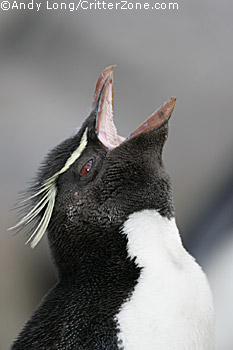 Rockhopper Penguin Eudyptes chrysocome chrysocome
Rockhopper Penguin Eudyptes chrysocome chrysocome
|
| It is late afternoon, and you're asked if you'd like to take a ride out to one of two drop-off points for an evening of photography. You're thinking to yourself, "Are they crazy? Of course I want to go out!" You answer the host politely and scurry off to get your gear ready. On the way to the drop off, your vehicle must swerve in order to miss a number of holes in the ground. As it turns out, these holes are actually nesting burrows built by Magellanic Penguins. Almost everywhere they inhabit, you'll see a penguin popping its head up from one of these burrows. |
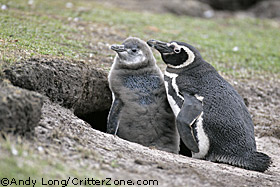
Magellanic Penguins Spheniscus magellanicus |
| It's summer in the Falklands, and the penguins are nesting. No matter which island and penguin colony you visit, you're sure to find parents sitting on an egg, fluff-ball nestlings, or juveniles ready to go out fishing on their own. It doesn't take long to realize that your trans-hemisphere journey for penguin photography was well worth every minute of being scrunched into a tight airplane seat. |
| My visit had two goals. The first was to add penguin images to my photography files, and the second was to scout out a new and exciting photo workshop. Months earlier, I'd been going through back issues of magazines to cut out articles of interest for future photo tours and photography workshops. Several of them had articles about penguins in the Falkland Islands. Two of the magazines covering this subject were published four years apart. I guess they were telling me it was something I must do, and I'm glad I followed that lead. About 6,500 photos later, I knew I had made the right decision. |
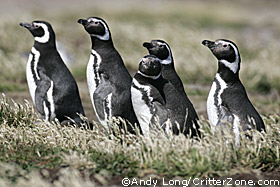
Magellanic Penguins Spheniscus magellanicus |
| I'd hoped to visit three of the outer islands on this trip. Unfortunately I waited until late in the year to make reservations, and I could only get to the main island and two of the outer islands. However, it didn't matter, as I got to do plenty of fun and exciting penguin photography. |
| My first stop was Saunders Island. The island has two primary locations for wildlife viewing and photography. One area is called "The Rookery." It has colonies of Rockhopper Penguins and Black-browed Albatross, Diomedea melanophris. I first came across the albatross colony, and it was hard to leave them for the Rockhopper location. When conditions are right, you'll witness adult albatross gracefully soaring just off the cliffs at eye-level. Take-offs are not quite so graceful. Albatross require a running start to take flight. There are several areas you can sit in the grass at spectator level, and watch them stumble by for takeoff, a mere 10 feet in front of you. |

Black-browed Albatross Diomedea melanophris |
It doesn't take long to notice that the animals of the Falklands aren't afraid of humans. In fact, one group of adolescent Gentoo Penguins went out of their way to surround me, carefully observing what I was doing from only a foot or two away. Once they realized I didn't have anything to eat, they waddled back to their colony.
Upon entering the Rockhopper Penguin colony at The Rookery, I was treated to an unusual sighting, a Macaroni Penguin. While they call the Falkland Islands home, they usually reside in harder to reach areas. Luckily for me, a few were mixed in among the Rockhopper Penguins. |

Macaroni Penguin Eudyptes chrysolophus |
The other viewing spot on Saunders Island is called "The Neck." It's a small isthmus where the diversity of subjects will keep you enthralled from dawn 'til dusk. This area supports a colony of Rockhopper Penguins, a colony of Gentoo Penguins, and plenty of Magellanic Penguins, but the main attractions are the King Penguins. They come to this spot to nest and raise their young. At the time, I only saw a couple dozen of these majestic birds, but it was more than enough to keep me fascinated observing their behavior. They're very similar to the Emperor Penguins made popular by Hollywood. The main difference is that King Penguins are about 6"-8" shorter than Emperor Penguins. King Penguins also nest within day trip range of the main town of Stanley. Volunteer Point has over 1,000 of these beautiful birds, and excursions are available from several local guides. |

King Penguins courtship Aptenodytes patagonicus |
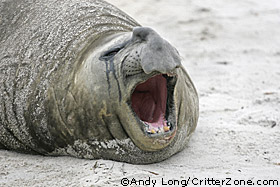
Southern Elephant Seal Mirounga leonina |
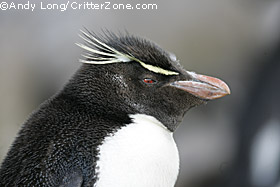
Rockhopper Penguin |
| The Falkland Islands has 18 locations with at least one species of penguin or nesting birds, but not all are set up for overnight accommodations. While I wanted to go to three of the outer islands, I was only able to get to two. (In the future when I run photography workshops to the Falklands, I intend to go to three different shooting locales.) However, I wasn't too upset because I was having a great time on Sea Lion Island, which has loads of good photo opportunities. There you'll find a Gentoo Penguin colony with lots of action, and it's situated very close to the guest building. Within a few minutes walk from that spot, you'll find a beach inhabited by Southern Elephant Seals, Mirounga leonina. The same beach has Magellanic Penguins swimming ashore after their ocean fishing excursions. It's very easy to get close-up viewing of them bobbing about out in the water. A bit further away, Rockhopper Penguins and King Cormorants Phalacrocorax atriceps can be found. The easiest flight photography I've ever encountered was of the King Cormorants returning to shore after their ocean fishing adventures. |

Magellanic Penguin Spheniscus magellanicus |
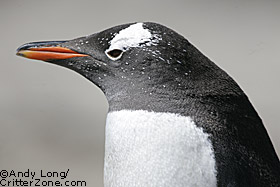
Gentoo Penguin Pygoscelis papua |
A person must plan far ahead to see all the Falkland Islands have to offer. The weather can be a limiting factor and needs to be taken into account. I was scheduled for a trip to the Volunteer Point King Penguin colony, but 70 mph winds kept all small planes grounded, including my ride to Stanley.
As soon as I got home, I started making plans for a Falkland Islands workshop in 2008. Even a year in advance, not all options were available, but it'll still be a fantastic trip! Each island has very limited visitor accommodations, around 10 to 12 people maximum. Knowing there won't be a crowd to fight makes for a peaceful and enjoyable time with the native wildlife. |
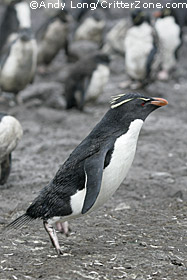
Rockhopper Penguin
Eudyptes chrysocome chrysocome |
This exciting trip is sure to be on my photography workshop schedule for years to come. The best thing about the Falkland Islands is being able to observe penguins at very close range. You're so close it's quite easy to witness their quirky behaviors, and come home with great photographs to hang on your wall.
My Falkland Islands photo workshop space is limited. If you're interested in participating, be sure to visit my website for the schedule and sign up form:
Falkland Islands Penguin Photo Workshop
Andy Long / CritterZone.com
First Light Photo Tours |
The penguin pictures on this page are available for commercial stock photography license from CritterZone.com. All text and photos that appear on this webpage are copyrighted and may not be copied or used in any way without permission from Andy Long or CritterZone.com.
CritterZone does not specifically endorse our advertisers, or their methods. We cannot control the ads that run on our articles. CritterZone advocates humane and respectful treatment of all creatures. |
Save this page:

|